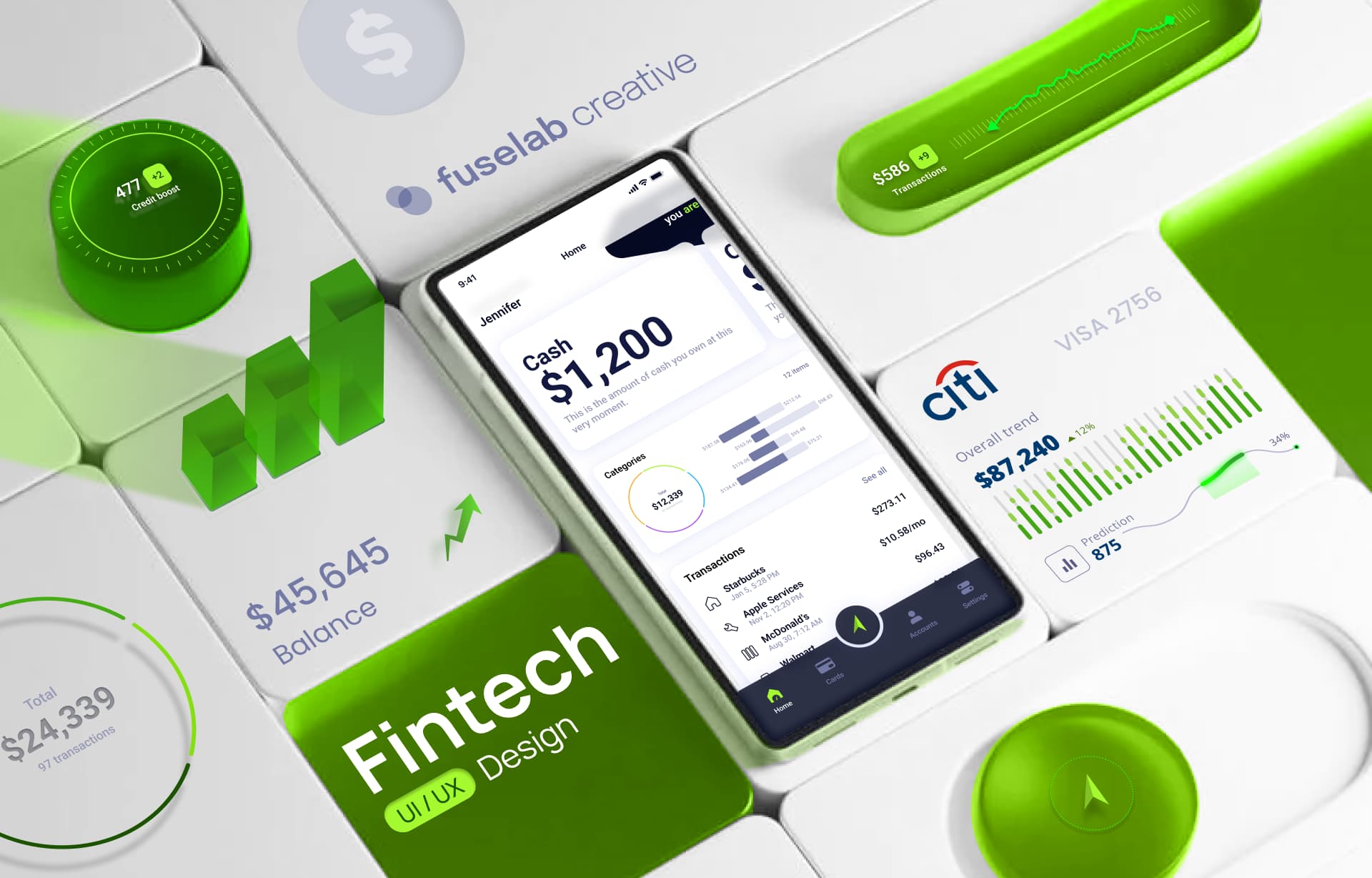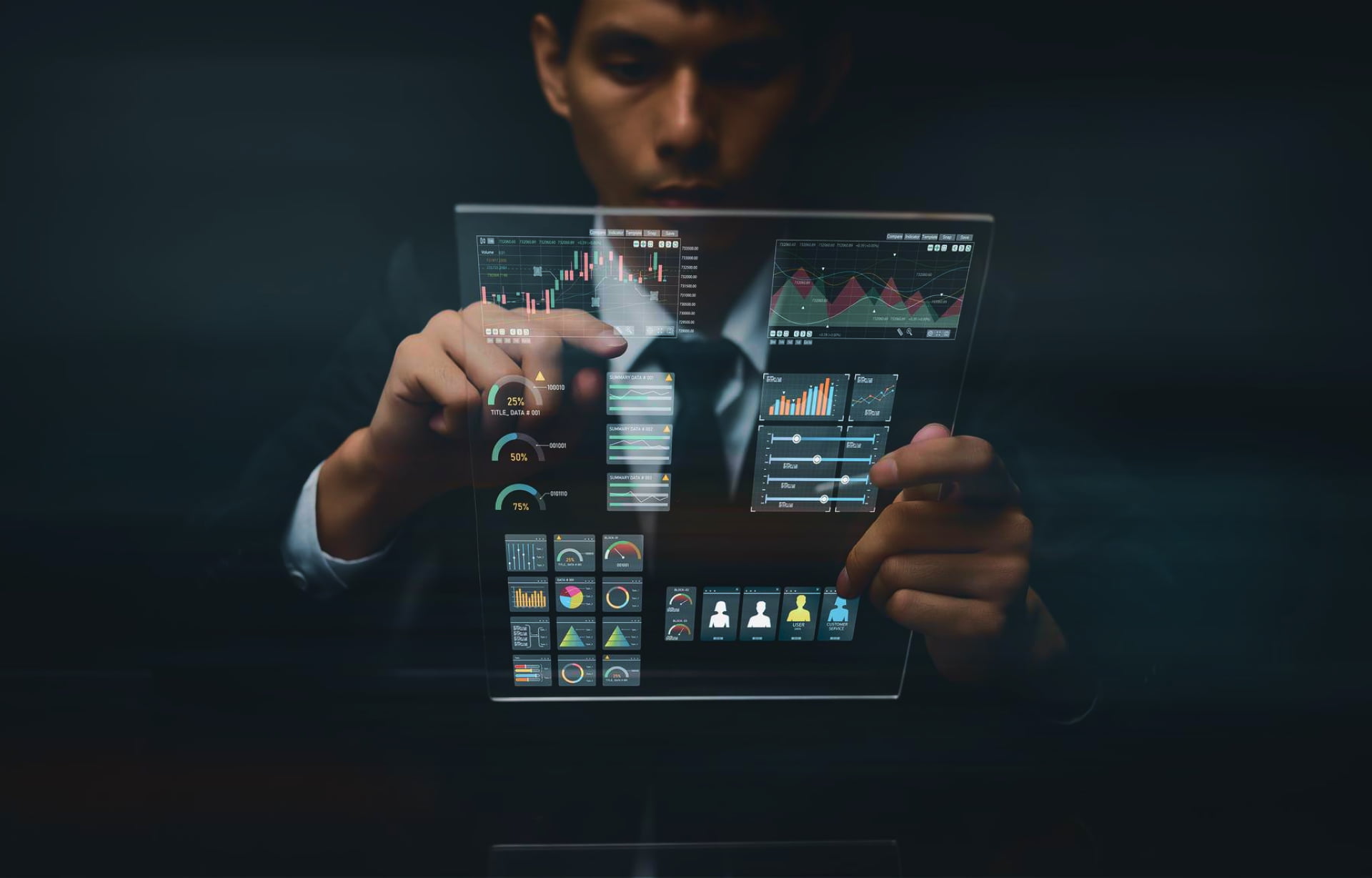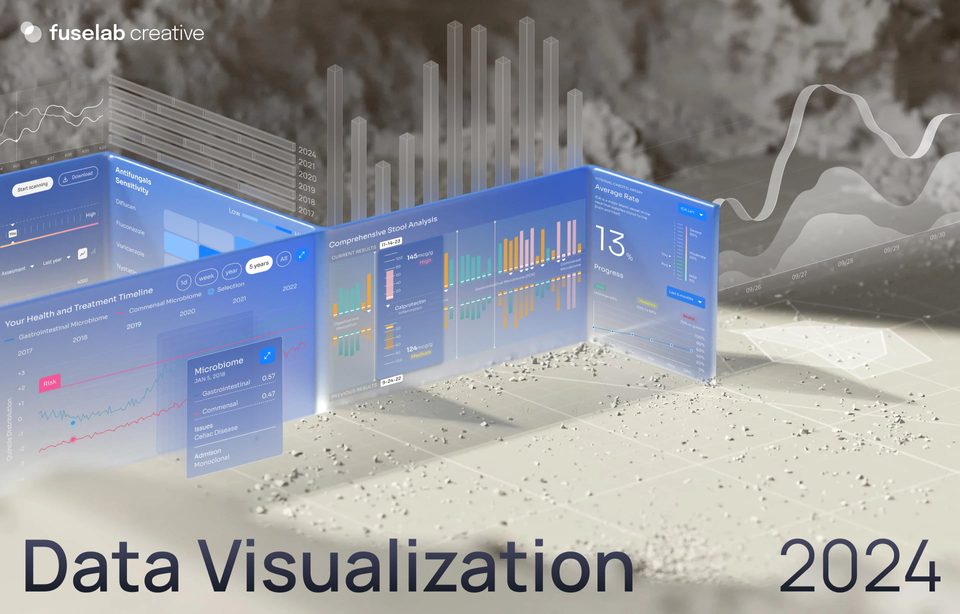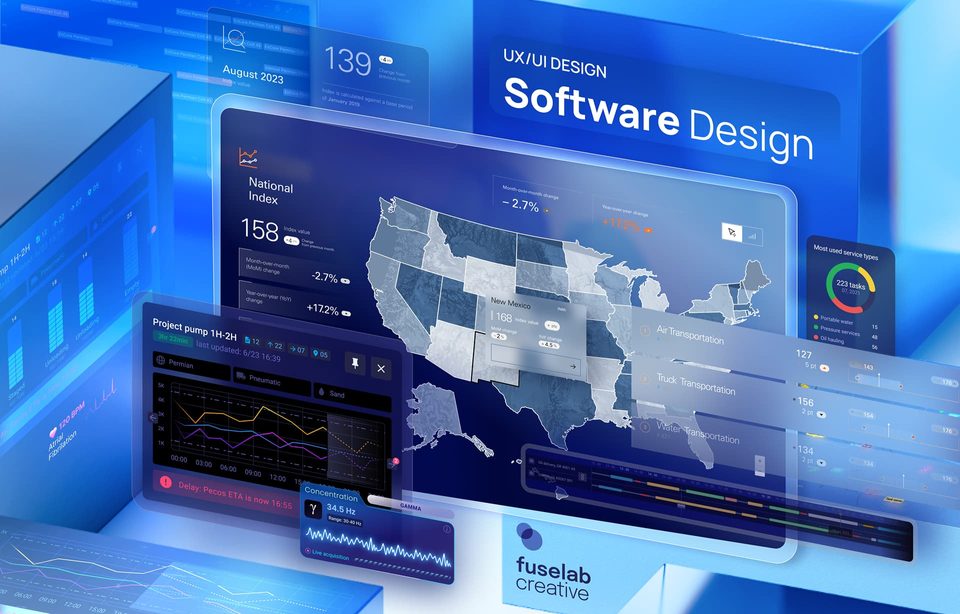What Will the Future of Fintech UI/UX Design Look Like

![]()
If there is one constant in the finance sector, it is the upward trend of digitization. The last decade has seen the finance industry decentralize its unified banking processes into smart and agile fintech products.
Fintech, short for financial technology, refers to innovative solutions that leverage technology to enhance and streamline financial services. These encompass a broad spectrum, including digital payments, mobile banking, robo-advisors, peer-to-peer lending, and blockchain-based solutions.
Fintech has been instrumental in democratizing access to financial services. These services are user-friendly and accessible, bringing millions of underserved customers into the world of money and credit. However, their success hinges on how well these digital applications and processes serve their customers and employees and on whether they can communicate evolving trends, innovations, and challenges that define the new age of finance to the end users of their products. This is where fintech UI/UX research and design come in.
Before we look at design trends that are shaping the future of fintech UI/UX design, we need to understand the key challenges fintech designers typically set out to solve.
To ensure that finance products and applications empower their users, they need to be designed more thoughtfully and work seamlessly. It is vital to ensure that the application removes friction, enhances the user experience, and extends the engagement between the users and the product while also guaranteeing safety and data privacy. This might seem like a lot of boxes to tick, but prioritizing UI/UX design from Day 1 of the product ideation phase will ensure that fintech companies can deliver on every item on the checklist.

UX Design for Fintech: Navigating Complex Challenges
Designing a fintech product comes with its own set of challenges: it has to blend functionality with ease of use without losing the details of financial interactions or compromising on security. Every fintech graphic design approach needs to consider the following:
Security Concerns: All financial data is very sensitive, which is why the fintech industry must prioritize security above all in their digital product design. However, the design approach must strike a delicate balance between strong security measures and a frictionless user experience.
Regulatory Compliance: The fintech industry is also subject to stringent regulations, and for global players, these vary across jurisdictions. Fintech UX design must also factor in these regulations and build in necessary disclosures, consent mechanisms, and data protection measures.
Financial Literacy: Positioned as a democratizer of finance, fintech product ideas must be made accessible and usable for users who may not possess a deep understanding of financial concepts. It must also fill the role of a financial educator or guide that gives its users the critical knowledge they need to make informed decisions.
Cross-Device Consistency: Tablets, smartphones, laptops, and more—users are accessing fintech products across various devices; hence, maintaining consistency is a challenge for anyone looking to design financial solutions. As more and more people move to mobile devices, especially their phones, fintech designers need to focus on mobile banking UI design to provide a cohesive experience without sacrificing functionality or aesthetics.

Fintech Design Trends: A Glimpse into the Future
Mobile-first design
Design-thinking in fintech is already moving towards a mobile-first approach, and in the future, we will see this trend expand even more. As more and more users step away from the brick-and-mortar financial institutions and the usual reams of paperwork that typify traditional finance and banking, they will come to rely more on their apps, and the design approach will need to factor in intuitive and responsive interfaces optimized for smaller screens while maintaining a seamless experience across devices.
Personalization
Design that replicates the personalized approach that bank branches offer is also something digital banking UX and UI will need to embed into their design processes. This means that interfaces will need to be tailored to individual user preferences, leveraging data analytics for personalized recommendations, and incorporating human-centric design principles to foster user engagement and satisfaction.
Data visualization for finance
A key part of attracting users to engage with and use fintech products and applications will be to make the increasingly complex financial data more understandable to the average customer and employee. Using graphically meaningful ways to represent financial data will continue to remain one of the key features of fintech design.
Interactive charts, graphs, and dashboards enable users to comprehend complex financial information at a glance, empowering them to make informed decisions. Adding a layer of machine learning algorithms will make data visualizations predictive and help users understand the relationships between their various financial decisions.

Deeper Integration of AI and Machine Learning
Artificial Intelligence (AI) and Machine Learning (ML) have already found deeper integration in our daily lives, and finance is at the forefront of leveraging these emerging technologies. Fintech UI design trends will need to keep furthering the changes brought on by predictive analytics, fraud detection, and intelligent automation while also delivering proactive and personalized user experiences.
Gamification in fintech
Money has always been a serious business; however, now many fintech products want to engage with everyday users by making money matters on their apps less stressful, more fun, and more interactive.
Adding gamification elements such as accomplishments, leaderboards, rewards, and badges can elevate what is considered boring by many to a more engaging and interesting activity.
Unified features
Till now, the BFSI industry has viewed apps as an add-on to customer bank accounts; however, the trends in banking UX and UI are reimagining the app as a centralized and unified dashboard that has all the services of a bank branch in one place.
Going forward, the finance dashboard UI will be seen as a multi-functional portal that connects different apps, wallets, and accounts under one umbrella application.

Unified features
Till now, the BFSI industry has viewed apps as an add-on to customer bank accounts; however, the trends in banking UX and UI are reimagining the app as a centralized and unified dashboard that has all the services of a bank branch in one place.
Going forward, the finance dashboard UI will be seen as a multi-functional portal that connects different apps, wallets, and accounts under one umbrella application.
Humanization of fintech functionalities
Designing with the user in mind is gaining more prominence in fintech dashboard design. Traditionally, the fintech design system was about providing access to the closed banking functions of the branches to users on their devices. The bank and its requirements drove the design process, with the users coming in as an afterthought. Now, UI is more user-centric, and emotive design is a trend that is being used to attract more users and set a fintech product apart from its competitors.
Gesture-Based Navigation: Screen space is limited, and the navigation and menu of a fintech product are often very detailed. A new feature, gesture-based navigation such as actions like swiping, tapping, and pinching, is gaining momentum in the design of financial products as it frees up space, is more intuitive, and is quicker for users to take action.
Offline Functionality: People need their fintech apps anytime, anywhere, and sometimes this could be at a place with poor network connectivity! To build an always-on application, designers must build for an unstable internet connection, ensuring UX design for fintech incorporates offline functionality.

Biometric Authentication: Almost all smartphones and digital devices come with biometric access features, and they add an extra layer of security to the devices as well as all the data in them. Fintech website design as well as app design is now also moving beyond passwords and pins and leveraging biometric authentication methods, such as fingerprint or facial recognition. Users naturally appreciate the ease of logging in with a simple touch or glance, which reduces reliance on traditional passwords while also providing unmatched security.
Focus on aesthetics and language
While fintech products will always be functionality first, one cannot understate the importance of visual appeal. Users tend to naturally gravitate towards better-looking, cleaner, and simpler versions of apps. Hence, fintech design principles now must also consider bolder colors, fonts, and layouts and match them with simpler, easier-to-understand language and messages.
Crucial Steps For Designing A Successful Fintech Product
The banking functionalities a product demands might be non-negotiable; however, how you present these can be controlled by a fintech design. Working with a specialized design firm like ours can help you combine all the must-haves in a package that users like and engage with.
We believe the foundation of effective Fintech UI/UX design lies in user research. Understanding what your user wants, their pain points, preferences, and problems, and the patterns of their app usage, is essential for creating portals that resonate with the target audience. (Read more about the importance of UX here.)
Here are some key activities you should help your UI/UX designer complete in detail:
User Persona Development: The first step towards understanding your users is to start with a set of detailed user personas. These can help designers see them as individuals with specific traits, needs, and preferences and build the foundation of their designs targeted at solving the problems of a specific group of people.
Testing: A critical step is to help designers test their beta apps on real users. Their interactions can provide vital insights into how user groups will navigate and use the interface. Iterative testing helps refine the UI/UX based on actual user behaviors.
Surveys and Feedback Loops: Ensure that your fintech product has continuous feedback loops via surveys to allow designers to refine the UI/UX design iteratively.
Competitor Analysis: An important part of designing a fintech app is also analyzing competitors in the same space. Looking at what your competitors are doing can give your designers a good insight into industry best practices, emerging trends, and areas of differentiation.

Managing a Consistent Fintech Design System in the Long Run
As the world changes, so do the digital landscape and the needs of users. How can you design a fintech app that stays up-to-date?
Ensure feedback loops work and are listened to: Keep an eye on what your users are telling you. Often, small bugs and annoying navigation missteps are pointed out by users in their feedback or surveys. Make sure these surveys are analyzed and action is taken on any problems flagged by users.
Stay abreast of industry trends: Any changes in technology, compliance, or product structure should be marked for design improvements. You will also know how the industry is moving with periodic competitor analysis.
Be consistent with your brand image: Maintain a centralized repository of design elements, patterns, and guidelines that ensure consistency across all your products. Key components such as the design components library, color and typography guidelines, interaction patterns, and keyboard navigation patterns ensure that your product remains seamless to your users even years down the line.

The Future of Finance is Fun and Functional
Fintech is an industry that will continue to evolve and change to provide better experiences and services to its customers. The one sure-shot way to ensure you stay relevant is by designing for your users. Solve their problems, anticipate their needs, and give them the tools and knowledge to save and grow their money—and do all this in a visually appealing way!
While functionality is paramount in fintech design, aesthetics also play a crucial role in creating visually appealing and memorable interfaces. To create products that succeed now and in the future, work with our design team and blend our creative and empathetic approach with your financial expertise.


Browse more

Data Visualization Trends 2024
